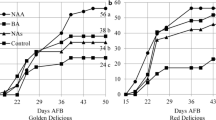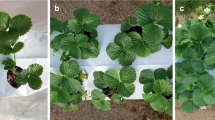Abstract
A mixture of 6-benzyladenine (BA) and gibberellins GA4 plus GA7 applied to “Pink Lady” apple at early phenological stages was previously shown to result in an immediate increase in epidermal cell density and associated reduction in calyx-end cracking disorder in the mature fruit, implying a long-term effect of the BA + GA4+7 mixture. Here, we analyzed the anatomical changes in the mature peel at the calyx end 210 days after full bloom (DAFB), following application of the plant growth regulators (PGRs) at the cell-division phase of fruit development, 21–50 DAFB. Experiments were conducted in northern Israel, and the PGRs were applied as the commercial formulation Superlon™ (Fine Agrochemicals Ltd.), composed of 19 g l−1 BA and 19 g l−1 GA4+7. Trees were sprayed with 0.025, 0.1, or 0.2 % (v/v) Superlon™. The most obvious phenomenon was the presence of epidermal cell clusters within the cuticular matrix that were detached from the native epidermal layer located at the bottom of the cuticle and which could not be detected in the untreated control fruits. Treatment with 20 mg l−1 BA + GA4+7 (0.1 % Superlon™) resulted in a markedly thicker cuticle, a higher percentage of detached epidermal cells within the cuticular membrane and a significant reduction in calyx-end cracking at harvest. The presence of cuticle-embedded epidermal cell clusters may have contributed to strengthening the peel by adding more cell-wall components, thickening the cuticle layer and possibly enhancing crack repair.




Similar content being viewed by others
References
Belding RD, Blankenship SM, Young E, Leidy RB (1998) Composition and variability of epicuticular waxes in apple cultivars. J Am Soc Hortic Sci 123:348–356
Ben-Arie R, Saks Y, Sonego L, Frank A (1996) Cell wall metabolism in gibberellin-treated persimmon fruits. Plant Growth Regul 19:25–33
Bird SM, Gray JE (2003) Signals from the cuticle affect epidermal cell differentiation. New Phytol 157:9–23
Biton E, Kobiler I, Feygenberg O, Yaari M, Friedman H, Prusky D (2014) Control of alternaria black spot in persimmon fruit by a mixture of gibberellin and benzyl adenine, and its mode of action. Postharvest Biol Technol 94:82–88
Curry EA (2009) Growth-induced microcracking and repair mechanisms of fruit cuticles. In Plant physiology. Proceedings of the SEM Annual Conference, June 1–4, 2009, Albuquereque
Eccher T (1975) Influenza di alcuni fitormoni sulla rugginosita della ‘Golden Delicious’. Riv Ortoflorofrutticoltura Ital 59:246–261
Faust M, Shear CB (1972) Russeting of apples, an interpretive review. HortSci 11:233–235
Fogelman E, Redel G, Doron I, Naor A, Ben-Yashar E, Ginzberg I (2009) Control of apple russeting in a warm and dry climate. J Hortic Sci Biotechnol 84:279–284
Ginzberg I, Fogelman E, Rosenthal L, Stern RA (2014) Maintenance of high epidermal cell density and reduced calyx-end cracking in developing ‘Pink Lady’ apples treated with a combination of cytokinin 6-benzyladenine and gibberellins A4+A7. Sci Hortic 165:324–330
Johansen DA (1940) Plant microtechniques. McGraw-Hill Book Company, Inc., New York
Khanal BP, Grimm E, Knoche M (2013) Russeting in apple and pear: a plastic periderm replaces a stiff cuticle. AoB Plants 5:pls048
Kim H, Lee SB, Kim HJ, Min MK, Hwang I, Suh MC (2012) Characterization of glycosylphosphatidylinositol-anchored lipid transfer protein 2 (LTPG2) and overlapping function between LTPG/LTPG1 and LTPG2 in cuticular wax export or accumulation in Arabidopsis thaliana. Plant Cell Physiol 53:1391–1403
Knoche M, Khanal BP, Stopar M (2011) Russeting and microcracking of ‘Golden Delicious’ apple fruit concomitantly decline due to gibberellin A4+7 application. J Am Soc Hortic Sci 136:159–164
Koch K, Ensikat H-J (2008) The hydrophobic coatings of plant surfaces: epicuticular wax crystals and their morphologies, crystallinity and molecular self-assembly. Micron 39:759–772
Konarska A (2013) The structure of the fruit peel in two varieties of Malus domestica Borkh. (Rosaceae) before and after storage. Protoplasma 250:701–714
Kurdyukov S, Faust A, Nawrath C, Bar S, Voisin D, Efremova N, Franke R, Schreiber L, Saedler H, Metraux JP, Yephremov A (2006) The epidermis-specific extracellular BODYGUARD controls cuticle development and morphogenesis in Arabidopsis. Plant Cell 18:321–339
Lewis LN, Coggins CW, Labanauskas CK, Dugger WM (1967) Biochemical changes associated with natural and gibberellin A3 delayed senescence in the navel orange rind. Plant Cell Physiol 8:151–160
Martin LBB, Rose JKC (2014) There’s more than one way to skin a fruit: formation and functions of fruit cuticles. J Exp Bot. doi:10.1093/jxb/eru301
McFarlane HE, Shin JJH, Bird DA, Samuels AL (2010) Arabidopsis ABCG transporters, which are required for export of diverse cuticular lipids, dimerize in different combinations. Plant Cell 22:3066–3075
Morice IM, Shorland FB (1973) Composition of the surface waxes of apple fruits and changes during storage. J Sci Food Agric 24:1331–1339
Oshima Y, Shikata M, Koyama T, Ohtsubo N, Mitsuda N, Ohme-Takagi M (2013) MIXTA-Like transcription factors and WAX INDUCER1/SHINE1 coordinately regulate cuticle development in Arabidopsis and Torenia fournieri. Plant Cell 25:1609–1624
Roy S, Conway WS, Watada AE, Sams CE, Erbe EF, Wergin WP (1999) Changes in the ultrastructure of the epicuticular wax and postharvest calcium uptake in apples. HortSci 34:121–124
Ruzin SE (1999) Plant microtechnique and microscopy. Oxford University Press, New York
Shi JX, Adato A, Alkan N, He Y, Lashbrooke J, Matas AJ, Meir S, Malitsky S, Isaacson T, Prusky D, Leshkowitz D, Schreiber L, Granell AR, Widemann E, Grausem B, Pinot F, Rose JKC, Rogachev I, Rothan C, Aharoni A (2013) The tomato SlSHINE3 transcription factor regulates fruit cuticle formation and epidermal patterning. New Phytol 197:468–480
Shi JX, Malitsky S, De Oliveira S, Branigan C, Franke RB, Schreiber L, Aharoni A (2011) SHINE transcription factors act redundantly to pattern the archetypal surface of Arabidopsis flower organs. Plos Genet 7(5):e1001388. doi:10.1371/journal.pgen.1001388
Stern RA, Ben-Arie R, Ginzberg I (2013) Reducing the incidence of calyx cracking in ‘Pink Lady’ apple using a combination of cytokinin 6-benzyladenine and gibberellins (GA4+7). J Hortic Sci Biotechnol 88:147–153
Vanstreels E, Alamar MC, Verlinden BE, Enninghorst A, Loodts JKA, Tijskens E, Ramon H, Nicolao BM (2005) Micromechanical behavior of onion epidermal tissue. Postharvest Biol Technol 37:163–173
Veraverbeke E, Van Bruaene N, Van Oostveldt P, Nicolaï B (2001) Non destructive analysis of the wax layer of apple (Malus domestica Borkh.) by means of confocal laser scanning microscopy. Planta 213:525–533
Yephremov A, Wisman E, Huijser P, Huijser C, Wellesen K, Saedler H (1999) Characterization of the FIDDLEHEAD gene of Arabidopsis reveals a link between adhesion response and cell differentiation in the epidermis. Plant Cell 11:2187–2201
Acknowledgments
This work is a contribution of ARO, the Volcani Center No. 108/2014. We thank Eduard Belausov for his technical help with the confocal microscopy.
Conflict of interest
The authors declare that they have no conflict of interest.
Author information
Authors and Affiliations
Corresponding author
Additional information
Handling Editor: Hanns H. Kassemeyer
Rights and permissions
About this article
Cite this article
Fogelman, E., Stern, R.A. & Ginzberg, I. Benzyladenine and gibberellin treatment of developing “Pink Lady” apples results in mature fruits with a thicker cuticle comprising clusters of epidermal cells. Protoplasma 252, 1009–1017 (2015). https://doi.org/10.1007/s00709-014-0736-7
Received:
Accepted:
Published:
Issue Date:
DOI: https://doi.org/10.1007/s00709-014-0736-7




